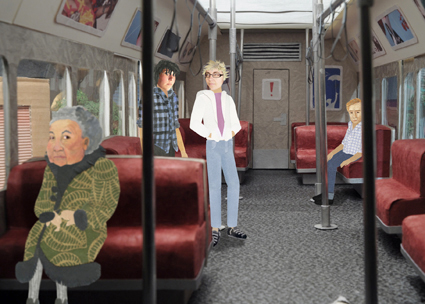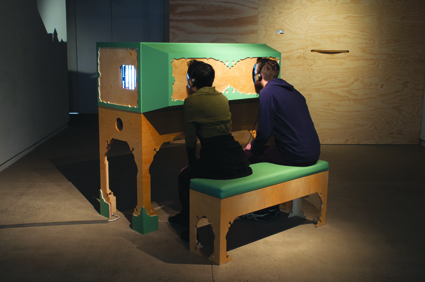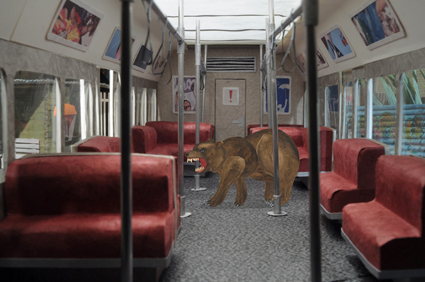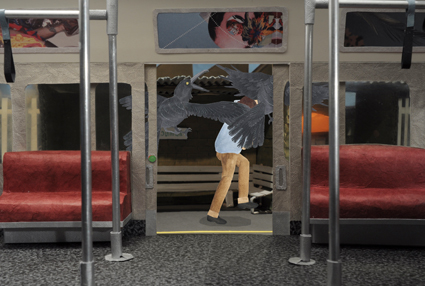interactivity, agency & the ethics of participation
ulanda blair: isobel knowles & van sowerwine, it’s a jungle in here

Isobel Knowles & Van Sowerwine, It’s a jungle in here
courtesy the artists
Isobel Knowles & Van Sowerwine, It’s a jungle in here
TRAVELLING BY PUBLIC TRANSPORT IS NOT AN EXPERIENCE WE TYPICALLY ASSOCIATE WITH COMFORT. AT ITS BEST CONVENIENT, AND AT ITS WORST FRIGHTENING, THIS DAILY RITUAL SEES HORDES OF URBAN COMMUTERS SILENTLY SLALOM THEIR WAY THROUGH MOMENTS OF PHYSICAL PROXIMITY AND PSYCHICAL DETACHMENT, HOPING FOR A CLEAR RUN.
It’s a jungle in here (2011), created by longtime collaborators Isobel Knowles and Van Sowerwine, uses the familiar experience of a suburban train journey to explore ideas of empowerment, complicity and individual and collective responsibility in public space. Drawing on the artists’ own personal experiences on public transport, as well as those of their friends, It’s a jungle in here is an equally enchanting but more conceptually rigorous follow-up to the duo’s You Were in My Dream (2010), winner of the coveted Premier of Queensland’s National New Media Art Award. Their latest interactive animation debuted at Screen Space for the 2011 Melbourne International Arts Festival.
A stop-motion animation made from paper puppets and a diorama, It’s a jungle in here harnesses similar technology to that employed in You Were in My Dream. Approaching the installation in pairs, participants unwittingly become involved in an ambiguous psychodrama, casting themselves in the role of either attacker or victim, depending on the seat they choose. The attacker is provided with a console button to advance the action, while the victim can yell into a microphone to derail the attack. A live video feed maps each of the users’ faces onto a different animated character, blatantly implicating them in the conflict.

Isobel Knowles & Van Sowerwine, It’s a jungle in here, installation view
courtesy the artists
Isobel Knowles & Van Sowerwine, It’s a jungle in here, installation view
The animation is housed within a wooden peepshow cabinet: a handcrafted ‘wonder box’ with just enough old-world charm to lure participants in and encourage play. At the same time however, the structure also gestures towards less innocent, contemporary live-action exchanges. More than just encouraging an active subjectivity, the peepshow box establishes the voyeuristic mode of spectatorship necessary for the work’s unsettling narrative thrust. Both users are immediately forced into a very physical mode of looking, manoeuvering their faces into peepholes, craning necks to absorb the scene from different angles, and focusing and refocusing to register the animation’s intricate detail. It’s a jungle in here thus forces an awareness of the very act of spectatorship, and the power, complicity and responsibility it demands.

Isobel Knowles & Van Sowerwine, It’s a jungle in here
courtesy the artists
Isobel Knowles & Van Sowerwine, It’s a jungle in here
In the first vignette, a male character fiddles loudly with his mobile phone, which raises the ire of a fellow passenger. Before long, a fistfight ensues. When the victim-player remains silent or quiet, the on-screen attacker suddenly morphs into a grizzly bear, bloodily mauling the man on the carriage floor. When the player uses the microphone to signal distress, their avatar suddenly transforms into a turtle, retracting into a hardened shell to protect itself against the predator.
Other confrontations enacted in the animation include a lecherous man forcing physical contact with a female passenger, and a gaggle of boisterous schoolgirls shooting spitballs and bubblegum. In the second scenario, the harasser’s hands become snakes that slither into the woman’s blouse. In the final scene, the schoolgirls metamorphose into carnivorous black crows, filling the cramped carriage with a murderous flapping. Significantly, throughout each altercation the surrounding travellers all cower silently, immobilised in their seats.

Isobel Knowles & Van Sowerwine, It’s a jungle in here
courtesy the artists
Isobel Knowles & Van Sowerwine, It’s a jungle in here
More than providing the focus for a meditation on the precarious relationship between humanity and animality, civilisation and chaos, the animal characters imbue the work with a seductive and fanciful beauty. It’s a jungle in here manipulates the participants’ allegiances and expectations at every turn, diluting the meaning and power of their violent actions through its sweet, picture-book aesthetic and whimsical calls to fantasy. By turns beautiful, dreamy, creepy and brutal, the work turns the ‘space of exception’ occupied by videogames and online social spaces in on itself, and in so doing, reveals how deeply those conventions are ingrained in the spectator psyche. In this way, It’s a jungle in here is startlingly effective in articulating an ethics of participation, both within the virtual world and outside it.
Isobel Knowles & Van Sowerwine, It’s a jungle in here, coding, interface electronics Matthew Gingold, carpentry, engineering Don Russell, sound Finn Robertson, additional coding Oliver Marriot; Screen Space, Melbourne, Oct 13-29 2011
RealTime issue #108 April-May 2012 pg. 22






